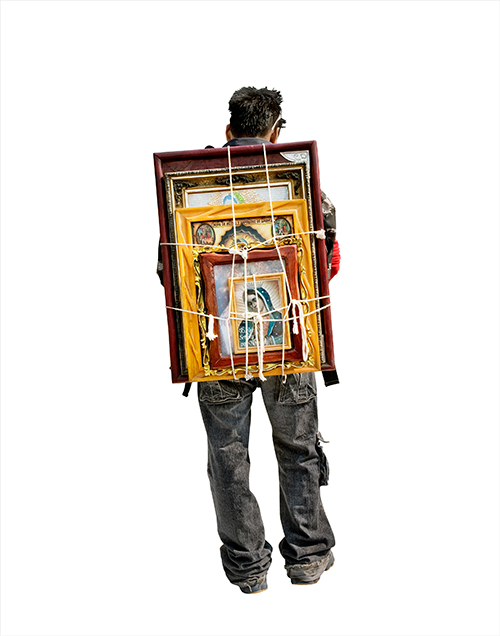 RIVERSIDE, Calif. – Scholars, artists and museum curators will examine sacred objects, rituals and visual culture of Latin America and Latinos in a conference at UC Riverside’s Culver Center of the Arts on Dec. 12-13.
RIVERSIDE, Calif. – Scholars, artists and museum curators will examine sacred objects, rituals and visual culture of Latin America and Latinos in a conference at UC Riverside’s Culver Center of the Arts on Dec. 12-13.
The conference, “Objects of Devotion/Objetos de Devoción,” coincides with an exhibition by Mexican-British photographer Alinka Echeverría, whose photographic series “The Road to Tepeyac” captures pilgrims and the objects they carry on their backs to Tepeyac Hill in Mexico City to honor the Virgin Mary on her feast day.
“There’s something about these photos that has captured people’s imaginations,” said Jennifer Scheper Hughes, associate professor of history at UCR and co-organizer of the conference. “This conference picks up themes from Echeverría’s work about devotion, Latin American religion and sacred vision.”
The conference is free and open to the public. Registration is recommended and may be done online. The Culver Center is part of UCR ARTSblock, located in downtown Riverside in the 3800 block of Main Street. ARTSblock is a cultural complex composed of the Culver Center, the California Museum of Photography and Sweeney Art Gallery.
Conference sessions begin at 3:30 p.m. on Friday, Dec. 12, and conclude with a screening of “Walking the Camino: Six Ways to Santiago,” a 2013 documentary that follows six pilgrims ranging in age from 3 to 73 on a 500-mile pilgrimage to Santiago de Compostela in Spain. A discussion will follow with co-producer Annie O’Neil and UCR art history professor Conrad Rudolph, both of whom have made the pilgrimage.
On Saturday, Dec. 13, the first conference session begins at 9 a.m. The day concludes with the final screening of “Walking the Camino” at 7 p.m. A conversation about the film will follow. “Walking the Camino” also screens at 3 p.m.
The conference features the participation of three Latin American/Latina women artists: Echeverría, who speaks on Friday and Saturday, in Spanish; Alma López, a visual and public artist whose work has appeared in more than 100 exhibitions around the world; and Colombian artist Adriana Salazar, who builds kinetic sculptures.
During the two-day conference national and international scholars will present more than 30 papers addressing many dimensions of religious materiality in the Latin American and Latino context, such as: relics, devotional practice, pilgrimage and iconography, visual and votive culture, contemporary engagements with the Virgin of Guadalupe, transgressive saints, and sacred objects and materials of the pre-Hispanic period. Plenary sessions will include conversations with artists and national/international scholars. One conference session on Dec. 13 will be held in Spanish.
“It was important to us in planning this conference to highlight the connections between Latin America and U.S. Latino experiences,” explained Jennifer Nájera, associate professor of ethnic studies and co-organizer of the conference. “Latino immigrants and their children maintain, challenge, and infuse new meaning into their religious practices and iconographies.”
On Thursday, Dec. 11, Luis León, author of “The Political Spirituality of Cesar Chavez: Crossing Religious Borders” (University of California Press, November 2014), will discuss the life and beliefs of the late farmworker advocate and union activist in a pre-conference lecture at 4 p.m. At 7 p.m. Teatro Latino will present a staged reading of the Migdalia Cruz play “The Have-Little.” The one-act play is a coming-of-age story about a 14-year-old girl growing up in a South Bronx tenement.
The Dec. 12 opening day of the conference coincides with the Feast of Our Lady of Guadalupe, a religious observance that honors the belief that Mary, the mother of Jesus and Mexico’s patron saint, appeared to a poor Indian in Mexico City twice in 1531.
Hughes, who studies Latin American religious practice, said that Mexican and Mexican American religious practices are often stigmatized in the U.S. because of their strong visual component.
“The history of this country is rooted in Protestantism, which has traditionally been against iconography and the religious image,” she explained. “The Puritans did not have an image of what Jesus looked like. For them, the image of Jesus was a blinding light. That has sometimes led to disrespect for Mexican religious practices. The Mexican relationship to the Virgin Mary is very complex and nuanced, but has been disparaged as idolatry. We’re trying to explain that these are complex positionalities. An image can be holy. It is never just an icon. At one point it is God, it’s a painting, it’s a representation.”
Hughes said she was inspired by Alinka Echeverría’s images of people making a pilgrimage to Our Lady of Guadalupe on Tepeyac Hill in Mexico City. The photographer’s series of 300 images of people and objects they carry on their backs to the shrine, “The Road to Tepeyac,” has been exhibited all over the world. It will be on display at the California Museum of Photography through Jan. 24, 2015.
Echeverría was named International Photographer of the Year in 2012 by the Lucie Awards, won the HSBC Prize for Photography in 2011, and has been nominated for the Paul Huf and Prix Pictet Awards.
Her work has been widely exhibited internationally, including at Maison European de la Photographie,Paris, National Portrait Gallery, London, and as part of the Moscow Photobiennale. She earned her M.A. in social anthropology at the University of Edinburgh in 2004, and studied photography at the International Center of Photography, New York.
View the conference schedule here.
Conference sponsors are: University of California Humanities Research Institute, and from UCR the Culver Center of the Arts, California Museum of Photography, the College of Humanities, Arts and Social Sciences, UC MEXUS (University of California Institute for Mexico and the United States), the Center for Ideas and Society, the UCR Tomás Rivera Chair, the Latin American Studies Program, and the departments of Ethnic Studies, History and History of Art.



